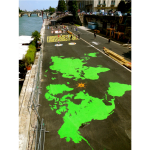 Reading & Composition: Energy, Society, and Environmental Design
Reading & Composition: Energy, Society, and Environmental Design
Comprised of 15 students, this course fulfilled one semester of the University-wide reading and composition requirement for undergraduate students. I taught this course as the solo instructor in Spring 2016 at the University of California, Berkeley. Met Tuesdays/Thursdays for 1.5 hours.
This course was designed to expose students to key pieces of contemporary literature that explore the relationship between climate change, society, and environmental design. To analyze the role of design—from the scale of the object to buildings and cities—in social and environmental sustainability, we critically analyzed texts, ideas, and arguments that inform a range of approaches to sustainable design, dissect debates regarding climate science and its implications, and critically reflected on the strengths and weaknesses of proposed solutions (and their articulation in written form).
Each week, students read and analyzed texts employing different styles of argumentation to elucidate a particular topic. Though representative of a broad range of sources—including academic journals, popular newspapers, and films—all texts focused on current issues about the intersection of sustainability, society, and the built environment. Through in-class activities and discussions students assessed the writing styles, forms of argumentation, and validity of conclusions, interventions, and solutions offered by each author; these ideas and skills were further developed by students in independent writing assignments. In the first half of the course, students honed their analytical (reading), evaluative, and argumentation (writing) skills with a series of short assignments; these activities, and the opportunities for feedback and iteration they allowed, prepared students to engage in a longer research paper in the second half of the semester.
Click here to view a PDF of the full syllabus. Click here to see the final paper assignment and how this deliverable was scaffolded by smaller assignments and both peer and instructor feedback.
 Designing for People: The Social Basis of Architecture and Urban Design
Designing for People: The Social Basis of Architecture and Urban Design
This syllabus outlines a proposed course for upper-division undergraduate students in and beyond architecture departments. In its current iteration, this course assumes a twice-weekly lecture and a weekly discussion section (90 minutes each), though it could easily be could be modified to a series of three 1-hour lectures each week or one 3-hour seminar once/week.
Following my interest in engaging student experiences as a basis for learning, this syllabus begins by providing students to reflect on the classroom environment that surrounds them:
When you arrived to class today, what made you decide to sit where you are sitting? Did you choose a spot next to someone else or not? Why are students and teachers separated in this space, and how do we all know where we are supposed to sit? And why do you have to sit while the teacher stands, anyway? What are the implications of this arrangement? In other words, what does this configuration convey in terms of power relationships or ideas about learning? How does it impact your behavior? What would happen if you decided to stand instead of sit?
This course investigates these and other questions relating to the assumed behavioral norms and (often unspoken) ideas that are embedded into the designed environments—in essence, any place or space that has been impacted by human intervention, including parks, buildings, gardens, streets, and sidewalks—in which we conduct our daily lives. Even empty spaces have social significance because we react to them, imbue them with meaning, and—sometimes—use them for activities that cannot be accommodated elsewhere. Indeed, built forms and the spaces they enclose are active participants in social life, signifying meaning, connoting value, and providing subtle cues for behavior. Said another way, all social life takes place in a physical setting, so to understand cultures and societies past and present requires a careful analysis of built forms and the spaces they create.
Rather than study solely built forms (as one might expect in an architecture course) or the people and societies that inhabit them (as is often the case in social sciences), the unit of analysis most meaningful in this course is person-in-environment; in other words, the interaction between people and places.
Click here to view a PDF of the full syllabus.